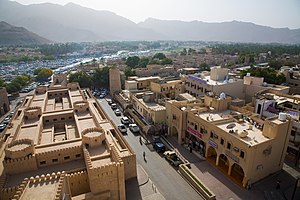Nizwa
|
Nizwa نزوى |
|
|---|---|
| City | |
| Nizwa | |
 |
|
| Location of Nizwa in Oman | |
| Coordinates: 22°56′N 57°32′E / 22.933°N 57.533°ECoordinates: 22°56′N 57°32′E / 22.933°N 57.533°E | |
| Country |
|
| Region | Ad Dakhiliyah Region |
| Government | |
| • Type | Absolute monarchy |
| • Sultan | Qaboos bin Said |
| Area | |
| • Metro | 3,500 km2 (1,400 sq mi) |
| Elevation | 492 m (1,614 ft) |
| Population (2008) | |
| • Metro | 120,000 |
| Time zone | Oman standard time (UTC+4) |
Nizwa (Arabic: نزوى Nizwā) is the largest city in the Ad Dakhiliyah Region in Oman and was the capital of Oman proper. Nizwa is about 140 km (1.5 hours) from Muscat. The population is estimated at around 72,000 people including the two areas of Burkat Al Mooz and Al Jabel Al Akhdar.
Nizwa is one of the oldest cities in Oman and it was once a center of trade, religion, education and art. Its Jama (grand mosque) was formerly a center for Islamic learning. Nizwa acquired its importance because it has been an important meeting point at the base of the Western Hajar Mountains. Set amid a verdant spread of date palms, it is strategically located at the crossroads of routes linking the interior with Muscat and the lower reaches of Dhofar thus serving as the link for a large part of the country. Today, Nizwa is a diverse prosperous place with numerous agricultural, historical and recreational aspects. Nizwa is a center for date growing and is the market place for the area.
Historians cannot agree on the origins of the name of the city. Some suggest the name was derived from the Arabic verb (Arabic: انزوا) which means being alone. Others say that the city was named after an old water spring.
Nizwa was the capital of Oman in the 6th and 7th centuries AD. With its deep connection to the root of Islam, Nizwa possesses a number of renowned mosques, such as Sultan Qaboos Jama (Friday mosque), So'al Mosque built in the 2nd century AH (9th century AD), Ash-Shawathinah Mosque in Uqr and Ash-Sharja Mosque. There are also Al-Ain Mosque, Ash-Sheikh Mosque and Shuraij Mosque in Tanuf built in 377 AH (around 1000 AD).
...
Wikipedia

